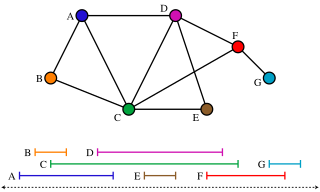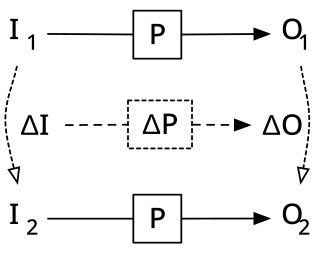Related Research Articles
In the computer science subfield of algorithmic information theory, a Chaitin constant or halting probability is a real number that, informally speaking, represents the probability that a randomly constructed program will halt. These numbers are formed from a construction due to Gregory Chaitin.
Gregory John Chaitin is an Argentine-American mathematician and computer scientist. Beginning in the late 1960s, Chaitin made contributions to algorithmic information theory and metamathematics, in particular a computer-theoretic result equivalent to Gödel's incompleteness theorem. He is considered to be one of the founders of what is today known as algorithmic complexity together with Andrei Kolmogorov and Ray Solomonoff. Along with the works of e.g. Solomonoff, Kolmogorov, Martin-Löf, and Leonid Levin, algorithmic information theory became a foundational part of theoretical computer science, information theory, and mathematical logic. It is a common subject in several computer science curricula. Besides computer scientists, Chaitin's work draws attention of many philosophers and mathematicians to fundamental problems in mathematical creativity and digital philosophy.
In computing, an optimizing compiler is a compiler that tries to minimize or maximize some attributes of an executable computer program. Common requirements are to minimize a program's execution time, memory requirement, and power consumption.

A greedy algorithm is any algorithm that follows the problem-solving heuristic of making the locally optimal choice at each stage with the intent of finding a global optimum. In many problems, a greedy strategy does not usually produce an optimal solution, but nonetheless a greedy heuristic may yield locally optimal solutions that approximate a globally optimal solution in a reasonable amount of time.

In the mathematical field of graph theory, a bipartite graph is a graph whose vertices can be divided into two disjoint and independent sets and such that every edge connects a vertex in to one in . Vertex sets and are usually called the parts of the graph. Equivalently, a bipartite graph is a graph that does not contain any odd-length cycles.

In graph theory, an interval graph is an undirected graph formed from a set of intervals on the real line, with a vertex for each interval and an edge between vertices whose intervals intersect. It is the intersection graph of the intervals.
In compiler design, static single assignment form is a property of an intermediate representation (IR), which requires that each variable is assigned exactly once, and every variable is defined before it is used. Existing variables in the original IR are split into versions, new variables typically indicated by the original name with a subscript in textbooks, so that every definition gets its own version. In SSA form, use-def chains are explicit and each contains a single element.

In graph theory, graph coloring is a special case of graph labeling; it is an assignment of labels traditionally called "colors" to elements of a graph subject to certain constraints. In its simplest form, it is a way of coloring the vertices of a graph such that no two adjacent vertices are of the same color; this is called a vertex coloring. Similarly, an edge coloring assigns a color to each edge so that no two adjacent edges are of the same color, and a face coloring of a planar graph assigns a color to each face or region so that no two faces that share a boundary have the same color.
In compiler optimization, register allocation is the process of assigning a large number of target program variables onto a small number of CPU registers.

In graph theory, an edge coloring of a graph is an assignment of "colors" to the edges of the graph so that no two incident edges have the same color. For example, the figure to the right shows an edge coloring of a graph by the colors red, blue, and green. Edge colorings are one of several different types of graph coloring. The edge-coloring problem asks whether it is possible to color the edges of a given graph using at most k different colors, for a given value of k, or with the fewest possible colors. The minimum required number of colors for the edges of a given graph is called the chromatic index of the graph. For example, the edges of the graph in the illustration can be colored by three colors but cannot be colored by two colors, so the graph shown has chromatic index three.
In computer science, instruction scheduling is a compiler optimization used to improve instruction-level parallelism, which improves performance on machines with instruction pipelines. Put more simply, it tries to do the following without changing the meaning of the code:

In graph theory, a circle graph is the intersection graph of a set of chords of a circle. That is, it is an undirected graph whose vertices can be associated with chords of a circle such that two vertices are adjacent if and only if the corresponding chords cross each other.
Rematerialization or remat is a compiler optimization which saves time by recomputing a value instead of loading it from memory. It is typically tightly integrated with register allocation, where it is used as an alternative to spilling registers to memory. It was conceived by Gregory Chaitin, Marc Auslander, Ashok Chandra, John Cocke, Martin Hopkins and Peter Markstein and implemented in the Pl.8 compiler for the 801 Minicomputer in the late 1970s. Later improvements were made by Preston Briggs, Keith D. Cooper, and Linda Torczon in 1992.

Incremental computing, also known as incremental computation, is a software feature which, whenever a piece of data changes, attempts to save time by only recomputing those outputs which depend on the changed data. When incremental computing is successful, it can be significantly faster than computing new outputs naively. For example, a spreadsheet software package might use incremental computation in its recalculation feature, to update only those cells containing formulas which depend on the changed cells.

In the study of graph coloring problems in mathematics and computer science, a greedy coloring or sequential coloring is a coloring of the vertices of a graph formed by a greedy algorithm that considers the vertices of the graph in sequence and assigns each vertex its first available color. Greedy colorings can be found in linear time, but they do not in general use the minimum number of colors possible.
In graph theory, a branch of mathematics, a crown graph on 2n vertices is an undirected graph with two sets of vertices {u1, u2, ..., un} and {v1, v2, ..., vn} and with an edge from ui to vj whenever i ≠ j.

In computational complexity theory, a problem is NP-complete when it can be solved by a restricted class of brute force search algorithms and it can be used to simulate any other problem with a similar algorithm. More precisely, each input to the problem should be associated with a set of solutions of polynomial length, whose validity can be tested quickly, such that the output for any input is "yes" if the solution set is non-empty and "no" if it is empty. The complexity class of problems of this form is called NP, an abbreviation for "nondeterministic polynomial time". A problem is said to be NP-hard if everything in NP can be transformed in polynomial time into it, and a problem is NP-complete if it is both in NP and NP-hard. The NP-complete problems represent the hardest problems in NP. If any NP-complete problem has a polynomial time algorithm, all problems in NP do. The set of NP-complete problems is often denoted by NP-C or NPC.
The multi-trials technique by Schneider et al. is employed for distributed algorithms and allows breaking of symmetry efficiently. Symmetry breaking is necessary, for instance, in resource allocation problems, where many entities want to access the same resource concurrently. Many message passing algorithms typically employ one attempt to break symmetry per message exchange. The multi-trials technique transcends this approach through employing more attempts with every message exchange.
In graph theory, an intervalI(h) in a directed graph is a maximal, single entry subgraph in which h is the only entry to I(h) and all closed paths in I(h) contain h. Intervals were described in 1970 by F. E. Allen and J. Cocke. Interval graphs are integral to some algorithms used in compilers, specifically data flow analyses.
References
- Gregory Chaitin (April 2004). "Register allocation and spilling via graph coloring". ACM SIGPLAN Notices. 39 (4): 66–74. doi:10.1145/989393.989403.
| This algorithms or data structures-related article is a stub. You can help Wikipedia by expanding it. |